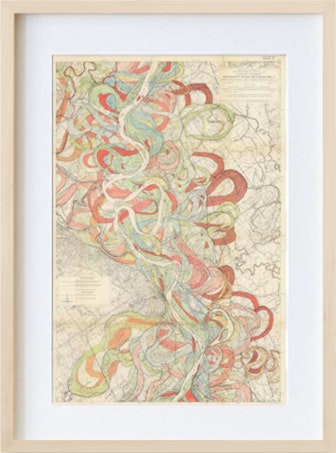
Etching of a Sámi Drum from the Dutch Edition of Johannes Schefferus’ Lapponia (1682)
For decades after Sweden’s participation in the Thirty Years’ War (1618–1648), a rumor persisted in Europe: that the monarch Gustavus Adolphus had contracted Sámi shamans to magically vanquish his Catholic foes. This likely wasn’t true, but the story may have fed on a lingering fear of the Finnish hakkapeliitta — ruthlessly efficient cavalry named for their battle cry of hakkaa päälle (roughly, “chop them down”) — who fought on behalf of Adolphus and were sometimes mistaken for Sámi. Fact or fiction, Magnus Gabriel de la Gardie, the Swedish Lord High Chancellor, took action in 1671, requesting that the Swedish College of Antiquities appoint a scholar to study the ways of the Sámi people, their territories, and to ascertain what role they had played in the Thirty Years’ War. The antiquarians decided the right man for the job was Johannes Schefferus, a professor of rhetoric and politics who had little prior knowledge about the Sámi, the indigenous peoples who inhabit Sápmi, a region of Fennoscandia that includes territories of modern-day Norway, Sweden, Finland, and Russia.
Born in Strasbourg, Johannes Schefferus (1621–1679) had been invited to Stockholm by Christina of Sweden, a monarch of unmatched erudition, who attempted to fashion the capital into an Athens of the North. Before she abdicated the throne and converted to Catholicism, she convinced Schefferus to write a history of the Pythagoreans, which Susanna Åkerman calls “the first modern history of its kind”. Schefferus applied a similar scholarly approach to his study of the Sámi, consulting antiquarian sources, medieval Nordic texts, travelogues, reports from government ministers, and accounts from Sámi university students. Of course, beyond the question of the Thirty Years’ War, his treatise played into colonial goals. As Linda Andersson Burnett argues, such a study was needed to support both a Swedish expansion into the northern territories for resource exploitation and a Protestant missionary agenda to civilize people they saw as mysterious and pagan. The fruits of Schefferus’ research appeared in Latin as Lapponia in 1673, with an English (1674), German (1675), French (1678), and Dutch (1682) edition soon following. (The English version, titled The History of Lapland, was arguably the first anthropological work published by Oxford University Press.)
Featured above is an etching by Jan Luyken of a runic drum used for ritual purposes, which comes from the Dutch edition of Lapponia. Schefferus learned about this particular drum from a Stockholmer named Laurence Norman, who sent him a drawing of the instrument, which was owned by Laurence Althnack, who, we are told, was taught to decipher it by Christopher Utterius, who, in turn, had first gleaned its symbolic meaning from “the Mouth of a certain Laplander, a Native of Torna”. This is all to say, no matter his intentions, Schefferus’ explanation is hearsay to the fourth degree.
This drum is cosmological in scope according to Schefferus (who presumably numbered its figures), depicting, inter alia: the river Torne (2), God (5), the Sun (6), the Moon (7), Saint Matthew (13), England (32), Turkey (36), the cities of Finland (39), the cities of Germany (41), a countryman (53), a bailiff (58), a bear (64), “the most dangerous and malicious sorcerers” (79), “the young One of a Raindeer” (87), a cat (89), the devil’s ditch (100), “the first President of the Assembly of Magicians” (117), “the fourth President of the same Assembly” (120), the gallows (124), health (147), “a mortal Wound given by a magical Javelin” (149), and the condition of “not [being] allowed to Sacrifice to any God of the Mountains, neither to the Trunk of a Tree, nor to any Stone, because this Character implies, that it will be in vain, and unsuccessful” (150).
While the symbols painted on these reindeer-hide drums have been subjected, by outsiders, to various interpretations, some equally far-fetched — devilish astronomies or geographical maps, spiritual allegories or pagan hieroglyphics — we know that the instrument itself supported divinatory, trance-like states, allowing the shaman (noaidi) to leave his body, travel over lake and mire, and solve imbalances between the known and invisible worlds that affected Sámi communities. The mystical symbolism came in two primary configurations: a “heliocentric” style in which figures revolved around a nexus or, as seen here, a “divided” drum face, in which partitions between conceptual groupings and various metaphysical realms were redoubled on the reindeer hide. Unfortunately, we can no longer consult the drum that Schefferus discussed in such detail, as it was lost or destroyed.
“Almost all Sámi drums were destroyed by Lutheran pastors”, write the curators at Siida — a museum in Inari, Finland, a municipality where 31% of the inhabitants are Sámi, according to a 2019 electoral census — and fewer than one hundred historical specimens are thought to survive today. Just as the myth of Sámi intervention in the Thirty Years’ War gripped the European imagination, their use of ritual instruments inspired fear and hatred in colonial officials. In 1688, fifteen years after the initial publication of Lapponia, Lars Nilsson, a shaman who lived in what is now the Arjeplog municipality of Sweden, had his drum confiscated with the threat of “temporal and eternal punishment” for its continued use. When his son later died, he seized another drum and used it to try and bring his child back to life. At his trial, Nilsson showed defiance, claiming that he would “observe and use the custom of his forefathers, in spite of what higher or lower authority in this case would now or in the future prohibit him from doing”. He was sentenced to death and burnt in a pyre stoked with his “divination drum and the tools belonging to it”.
Today, Sámi drums continue to disappear from museum collections. And even those under lock and key are estranged from the ceremonial contexts and communities that hold them as sacred. In 2022, the Danish government transferred ownership of a drum in the country’s National Museum to Riddo Duottar Museat, a Sámi museum in West-Finnmark, and last summer, Germany’s Meininger Museen in Thüringen returned a drum that was stolen in 1723 to the Samien Sijte Museum at Snåsa, Norway. For the numerous other objects (and Sámi human remains) awaiting repatriation, former president of the Sámi parliament Aili Keskitalo’s 2021 words still ring out: “We’ve been asking for years – it’s unacceptable.”
Oct 23, 2024






